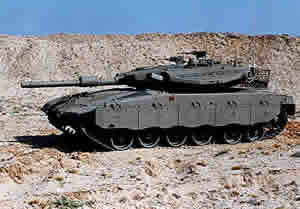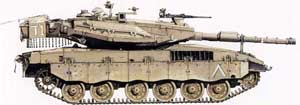| Designation: | MERKAVA Mk-3 |
 |
|---|---|---|
| Manufacturer: | I.M.I. Israel Military Industries Ltd | |
| Product type: | Armoured Vehicles | |
| Name: | Main battle tank |
Design work on the Merkava Mk 3 commenced in August 1983 shortly after the first production Merkava Mk 2 was handed over. First production Mk 3 was delivered to the 188th Armoured Brigade in the spring of 1989.
While the Merkava Mk 2 was an improvement of the original Merkava Mk 1, the Merkava Mk 3 is essentially a new design. The basic hull has been lengthened by 457 mm and additional fuel cells have been added to the hull rear.
The basic turret casting has been lengthened by 230 mm and the complete turret armour array around the crew redesigned to a modular configuration which can be changed or upgraded in the future.
The Merkava Mk 3 is built in production blocks and by mid-1996 at least three production blocks had been built. Block I and Block II differences were minor and mainly internal.
Block III changes were major and mainly external. These included turret armour components changed all round exterior, armour section on loader's side increased by 125 mm, 60 mm mortar port area significantly changed along with deflector area in front of the gunner's sight aperture.
The key improvements of the Merkava Mk 3 can be summarised as:
(1) Main armament is an Israel Military Industries 120 mm smooth bore gun fitted with a thermal sleeve. The 120 mm smoothbore gun is ballistically identical to that of the 120 mm smoothbore gun installed in the US M1A1 and M1A2 MBTs and German Leopard 2 MBTs. The 120 mm gun has an elevation of +20° and a depression of -7° with a total of 48 rounds of ammunition being carried. A 7.62 mm MG is mounted coaxially with the main armament and there are also two 7.62 mm roof-mounted machine guns; a total of 10,000 rounds of 7.62 mm ammunition is carried. Some of the 48 rounds of 120 mm ready use ammunition are in a drum on the floor of the turret compartment which provides the same degree of protection as the individual containers. The 60 mm mortar is aimed, loaded and fired from within the turret and, in addition to firing HE bombs against anti-tank teams, it can also fire illuminating rounds.
(2) Mounted either side of the turret is the Israel Military Industries CL-3030 instantaneous self-screening system for combat vehicles
(3) Turret controls are now all-electric with controls for both gunner and commander. The commander's panoramic sight has a magnification of x4 and x14, with an optical relay to the gunner's sight which is a two-axis stabilised day/night sight with a magnification of x5 (thermal) and x12 (day). The gunner's sight incorporates an Nd:YAG laser range-finder and automatic target tracker. The advanced fire-control system has been developed by ELOP and Elbit. The fire-control system is integrated with the turret- and gun-control equipment and allows line of sight stabilisation for the tank commander and gunner. It allows the Merkava Mk 3 to engage moving targets while it is also moving
(4) An advanced threat warning system developed by Amcoram is fitted, with threat warnings being displayed on a small panel at the commander's station
(5) The armour is of a modular special type and covers both the turret and hull. This armour provides a much higher degree of protection than that of the Merkava Mk 1 and 2 and can also be changed in the field. The new modular armour is attached to the hull and turret of the Merkava by bolts and as new armour systems become available they can replace the earlier armour packages
(6) The suspension is new consisting of 12 roadwheels independently mounted on trailing arms and sprung by pairs of concentric coil springs. The first two and last two roadwheel stations either side have a hydraulic rotary damper developed by SHL Ashot Ashkelon provides the final drives and suspension system for the Merkava Mk 3. Total roadwheel travel is 604 mm, 300 mm bump and 304 mm rebound
(7) It is powered by a Teledyne Continental AVDS-1790-9AR V-12 air-cooled diesel developing 1,200 hp and this is coupled to a new Ashot transmission
(8) The NBC system is still of the overpressure type but with a central filter and an air conditioning capability.
First round hit capability against moving targets is further enhanced by the installation of an Elbit Automatic Target Tracker (ATT) which automatically positions the aiming point accurately onto the target without operator interaction.
The ATT is based on image processing techniques implemented in the existing video source which can either be the thermal system or TV channel in the day sight.
The auto-tracker is of the centroid type and maintains the sight on the target once it has been laid by the tank gunner. The line of sight locks irrespective of the motion of the own tank and the target, and it brings the sight back on track even when the latter has been obscured for a short time such as by a terrain feature.
It has been confirmed that the Merkava Mk III is fitted with the Elbit Knight Mk III advanced computerised fire-control system.
The 120 mm smoothbore gun, which fires ammunition developed by Israel Military Industries, has been retained but improvements have been made to make the loader's job easier.
The forward part of the turret roof, to the immediate front of the commander's and loader's hatches, has been provided with an additional layer of passive armour to provide an increased level of protection against top attack weapons such as bomblets.
|
||||||||||||||||||||||||||||||||||||||||||
|
||||||||||||||||||||||||||||||||||||||||||||||||||||||
|
||||||||||||
Related Articles |
|
Sloped Armour (25.02.2013) |
|
Missile Tank (03.01.2013) |
|
General Dynamics Selected for Merkava Armored Personnel Carriers for Israel (31.10.2010) |
|
Elbit Systems Introduces at Eurosatory 2010: New Dual Remote Weapon Station (DRWS) (08.06.2010) |
|
Imco industries announced its top-of-the-line LED Lights - Illumination devices for armored fighting vehicles (07.06.2010) |
|
Infantry Fighting Vehicle (29.01.2007) |
|
Main Battle Tank (21.07.2006) |
|
General Dynamics Participates in Successful Trophy Active Protection System Experiments at DoD Test Facility (03.04.2006) |
|
ORCWS 25-30 Unmanned Turret System Completes Field Trials (22.12.2005) |
 |
 |
 |
 |
 |

